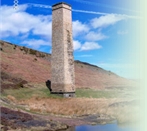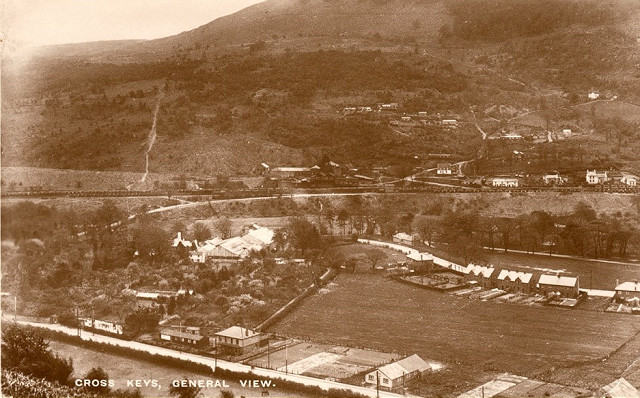Risca Blackvein Colliery
The Rough History
There are records of small-scale coal-mining in Waun Fawr going back to the 1670s. A timeline of serious mining is :-
1796 Edward Jones, 4 shafts inc whimsey, 3 levels
1836 Owned by John Russell
1846 Explosion, 35 fatalities
1847 Risca Coal and Iron Co, in liquidation 1862 (Russell)
1849 Red and Big Vein shaft made 16' x 10' and extended to 170 yds to Black Vein
1853 Explosion, 10 fatalities
1858 70 yds Upcast closed, 16x10 made upcast with Struves air pumps
1860 Explosion, 146 fatalities
1861 Fans removed, Furnace ventilation back, 16x10 now downcast, nearby circular smoke shaft
1863 Purchased by Thomas William Rhodes
1872 London and South Wales Colliery Co (Watts, Ward and Co)
1878 North Risca Colliery sinking begins
1880 North Risca Colliery explosion
1892 United National Collieries Ltd
1921 Coal winding ceased but kept for pumping ventilaton
1947 National Coal Board
1968 Closed and shafts filled
Waun Fawr Colliery was opened in circa 1796 as a whimsey shaft near the later brickworks, when Edward Jones built the double incline tramroad across the valley from the canal, seen by Archdeacon Coxe in 1799. Later, in 1841, with the expansion of Black Vein Colliery, it became known as the Old Ventilator shaft.
In 1840 David Mushett reported the following coal seams in use at Blackvein :-
- Upper Rock Vein, 3.5 ft thick - used principally for steam-packet purposes (ships)
- Lower Rock Vein 3.5 ft thick - a strong reedy coal
- Big Vein 8 - 12 ft thick - a weak slaty coal, small but free from Sulphur
- Sun Vein 4 ft thick - a strong compact reedy coal
- Red Vein 3 ft thick - a strong reedy coal
- Black Vein (or Rock Vein) - which has not been worked for a good many years
- Brass Vein which is accompanied by very good fireclay
Risca Black Vein Colliery opened in around 1841 when Waun Fawr was acquired by John Russell. The 'Monmouthshire Merlin' for 27th Nov 1847 reports 'At a meeting of the Monmouthshire Canal Co, Ironmasters & Coal owners, plus other freighters. Mr John Russell stated that he had just opened a new colliery and would now cost him £10,000 or £12,000 to bring the coal to the port.'. The colliery was also known as 'Risca Vale Colliery' in its early years.
It was a notorious pit, known as the death pit, due to the serious gas problems and frequent fatal accidents. The most serious occurred in 1860, under the Risca Colliery Co, resulting in 146 deaths, commemorated by the memorial on the opposite side of the valley. In all, around 200 lives were lost in the early 1800s. The explosion was a major factor in the bankrupting of the company and in 1872 it became the London and South Wales Coal Co. They decided to sink new shafts further north, the New Pits or North Risca Blackvein Colliery, and in 1878 Black Vein became the ventilation shaft for the new colliery. The Black Vein Colliery complex closed as a working colliery in 1921, being kept for ventlaton and access, the shafts were filled in 1968 and the whole area has been landscaped beside the Risca bypass.
Read Sam and Dave's memories of the area from the 1950s to the 1980s here
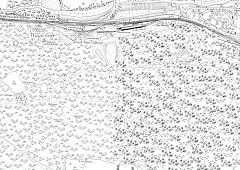
Blackvein, 1880
|
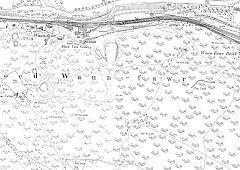
Blackvein Colliery, 1901
|
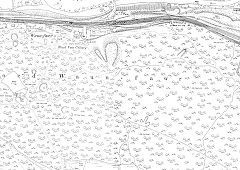
Blackvein Colliery, 1920
|
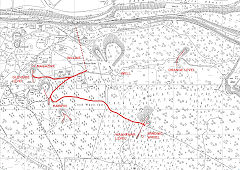
Blackvein Colliery, 1962
|
Up to 1900
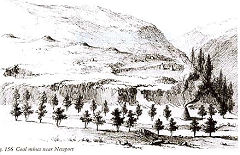
A sketch by J J Angerstein, c1760
|
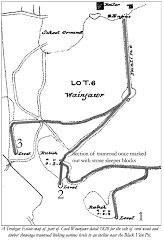
The Waunfawr Tramroad in 1828
|
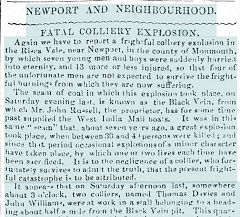
Risca Vale Colliery explosion, 1853
|
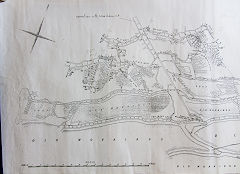
Underground workings, 1860
|
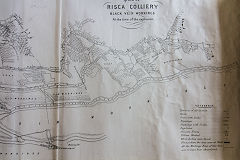
Underground workings, 1860
|
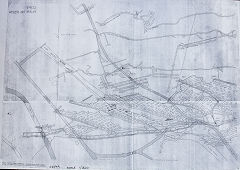
NCB abandonment plans
|
Early Period, c1900
Original headgear, tall chimney and curved roof to the screens.
The first two photos of the crowd scenes are believed to be from the 1912 National coal strike though there may have been a derailment at the time. These are looking North at the level crossing. Barbara Gill says :- "Stood behind the wheelbarrow are 2 Crosskeys boys aged 16. Sidney Pym wearing the watch chain and his best friend my great uncle Reginald Gill with the shovel over his shoulder. Reggie was a POW in WW1 and died of Spanish Flu on 11th November 1918. I don't know what happened to Sidney but he lived at Glenside I believe".
The third photo shows the same bowler-hatted gentleman, a reporter perhaps, with a different group of men and is believed to be looking South but it could be at North Risca Colliery.
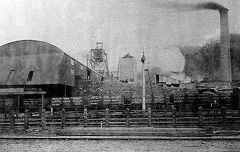
Blackvein Colliery, early period
|
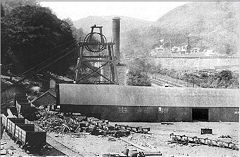
Blackvein Colliery, early period
|
|
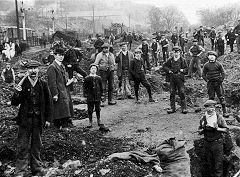
National Coal Strike, 1912
|
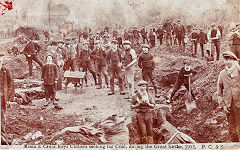
National Coal Strike, 1912
|
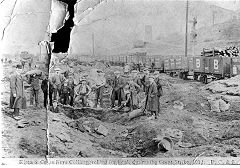
National Coal Strike, 1912
|
Middle Period, c1920
Later headgear, tall chimney and single pitched roof to the screens.
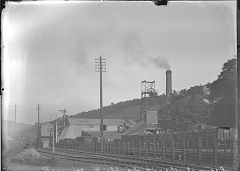
Blackvein Colliery, middle period
|
|
|
Later Period, c1930
Later headgear, short chimney and double pitched roof to the screens.
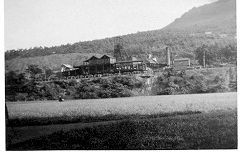
Blackvein Colliery, later period
|
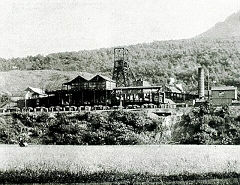
Blackvein Colliery, later period
|
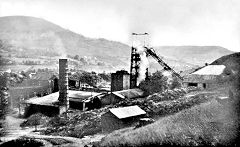
Blackvein Colliery, later period
|
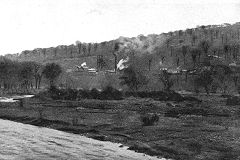
Blackvein Colliery, later period
|
Risca Blackvein Colliery in 1983
The Risca by-pass was built in the 1980s and the majority of the early workings were destroyed. Luckily a few photos were taken at that time.
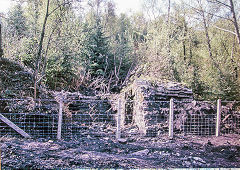
Blackvein Colliery engine house
|
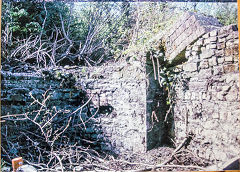
Blackvein Colliery engine house
|
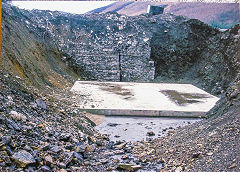
Jack-y-North Colliery shaft
|
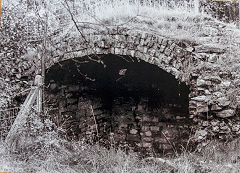
South of Blackvein Colliery
|
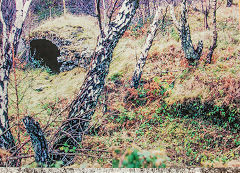
South of Blackvein Colliery
|
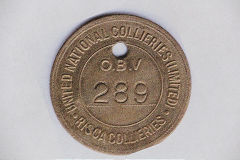
Risca Blackvein lamp check
|
Risca Blackvein Colliery today - ST 2242 9120
There is virtually nothing to see now of Risca Blackvein Colliery, quite different to what it used to look like. In 1836 John Russell and Co bought Waun-fawr Colliery with a site covering 1000 acres and in 1841 John Russell had a new shaft of 559 ft sunk at Coed Waun-fawr (Blackvein). The capped shafts are behind a strong steel fence to the South of Blackvein Road shortly after the underpass.
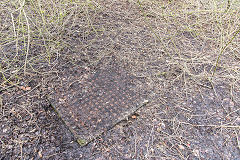
The manhole at the shafts
|
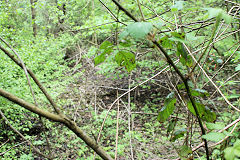
Risca Blackvein capped shafts
|
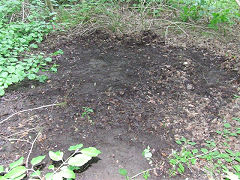
Risca Blackvein capped shafts
|
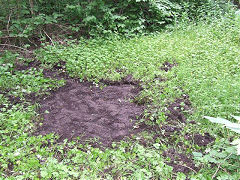
Risca Blackvein capped shafts
|
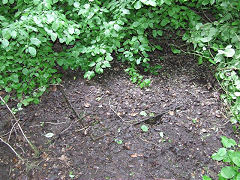
Risca Blackvein capped shafts
|
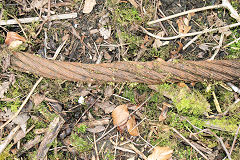
Wire cable next to shafts
|
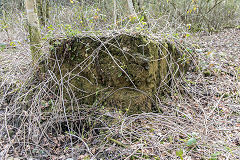
Concrete block behind shafts
|
|
Workings to the East of Blackvein Colliery
The 'orange' level - ST 2287 9102
In contrast to their destruction elsewhere Natural Resources Wales tree clearance has had some useful side-effects by clearing the undergrowth round these levels and tips at the bottom level. The prominent 'orange' level appears to have been the main one, running down to the larger Eastern tip with a shaft or collapse just above it. It's amazing that NRW were so careful here, why couldn't they be like this everywhere else?
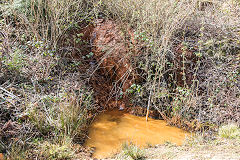
The 'orange' level
|
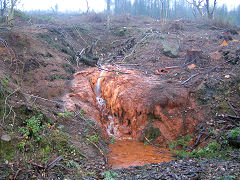
The 'orange' level
|
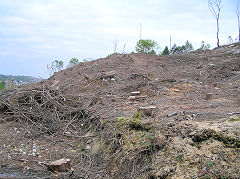
Shaft or collapse on the hillside
|
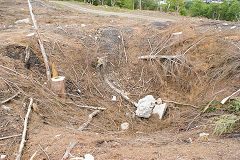
Shaft or collapse on the hillside
|
The smaller Western tip - ST 2284 9120
The larger Eastern tip - ST 2293 9110
It's not clear where the smaller tip came from but it could be a leftover of the landscaped main colliery tips. The larger tip appears to be the tip from the 'orange' level.
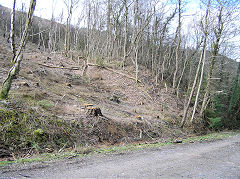
Western tip
|
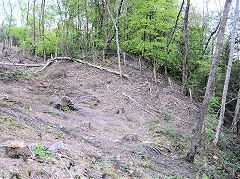
Western tip
|
|
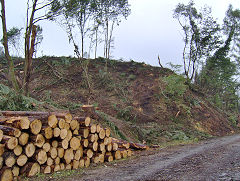
Eastern tip
|
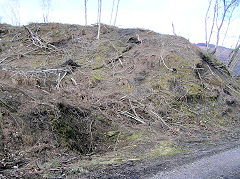
Eastern tip
|
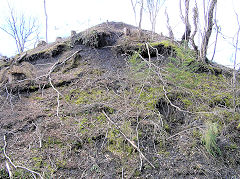
Eastern tip
|
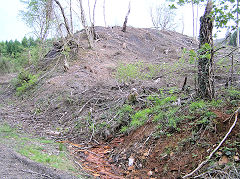
Eastern tip
|
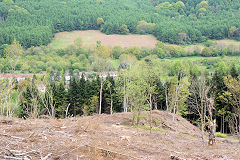
Eastern tip
|
Buck Farm level - ST 2312 9088
The Eastern-most level of the Blackvein area runs up from the tip directly behind Buck Farm.
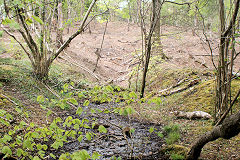
Buck Farm level
|
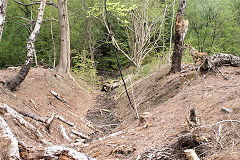
Buck Farm level
|
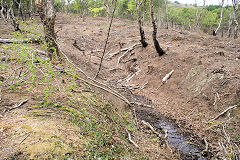
Buck Farm level
|
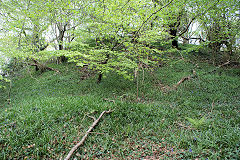
Buck Farm tip
|
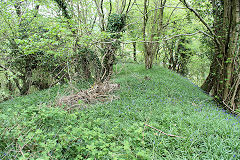
Buck Farm tip
|
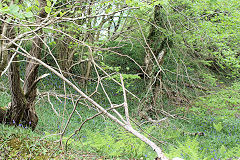
Buck Farm tip
|
Archdeacon Coxe, just where was his incline?
What the Archdeacon saw.....
Archdeacon Coxe passed through Risca on one of his tours in 1797 and he described the scene in his book 'A Historical Tour of Monmouthshire', published in 1801 :-
"On my way to Risca, I crossed a bridge over a rail road, lately formed by Mr. Edward Jones, who rents under Mr. Morgan of Ruperra some mines of lead, calamine, and coal, in Machen Hill, on the opposite side of the Ebbw. The expedition and security with which the cars are conveyed up and down the steep side of the precipice, appear singular to a spectator on the bridge. Two parallel rail roads are carried from the canal to the opposite side of the Ebbw, along which two cars are drawn up and let down at the same time, by means of an engine; they appear to pass each other alternately, like buckets in a well; a boy descends with the empty car, nearly midway, and after adjusting the machinery is again drawn up with the loaded car, which empties the coals into the boats of the canal."
The trouble is, no-one knows where the Archdeacon, his incline or Mr Jones' coal mines really were. Maps from 1809, 1813 and c1820, some years after the visit, and various letters and leases relating to Mr Jones exist and things on the ground have changed just a little since then.....
One mystery on the 1813 map is the naming of a 'Risca Colliery' next to the end of either route, there are no other maps showing a colliery here, nor any clear evidence on the ground. The c1820 map does show Darran Colliery so perhaps the 1813 map just has a mis-naming of that colliery. Both maps show the Sirhowy Tramroad which would have taken the coal traffic anyway.
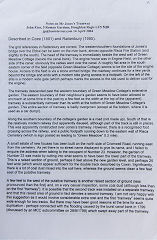
'Notes on Mr. Jones Tramroad'
by John Etor, page 1
|
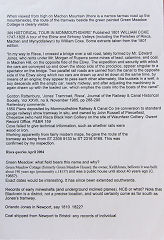
'Notes on Mr. Jones Tramroad'
by John Etor, page 2
|
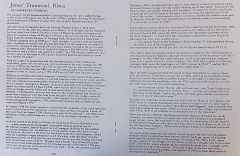
'Jones Tramroad, Risca'
by Gordon Rattenbury
|
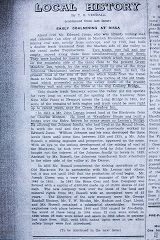
'Early coalmining in Risca'
by T E Yendell
|
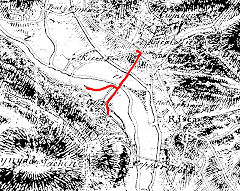
The route of Archdeacon Coxe's incline
|
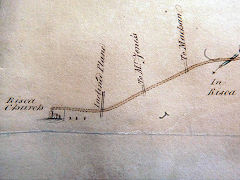
Map of Risca turnpike of 1809
|
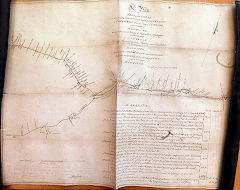
Map of Risca turnpike of 1809
|
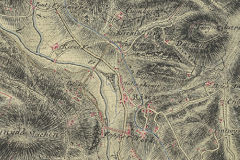
Map of 1813
|
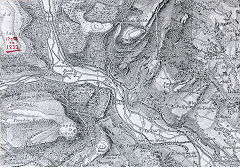
Map of c1820
|
Archdeacon Coxe's incline - ST 2315 9165
The route of the incline matches up geographically with what is now a steep footpath down from the canal, across the main road and over the river on a now-demolished bridge by the present-day fire station to the older Blackvein workings. This is a straight line from the workings to the canal and matches up well with Coxe's account. It is shown on the 1809 and 1813 maps. with branches to the colieries and is the generally accepted route by most historians. Gordon Rattenbury's article in the RCHS journal is the primary published account.
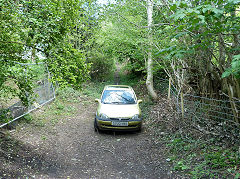
Looking up to the canal
|
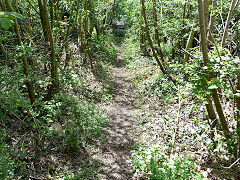
Looking down from the canal
|
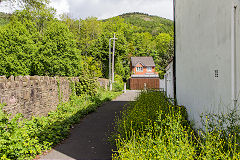
Looking up to the railway
|
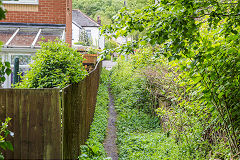
Looking down from the railway
|
Alternative access to Blackvein Colliery - ST 2302 9168 to ST 2255 9133
The lie of the land suggests that an alternative route could have been a more gentle incline from the canal down to the Monmouthshire Tramroad, past Medart Street, across Medart Place and along Blackvein Road over the river to the coal workings. Neither the railway nor Medart Street existed then but Medart Place was already the main road up the valley. However, it is hard to reconcile Coxes' account with this route which is not shown on the 1813 map. Bryan Morgan has done a lot of research into this area, particularly regarding the ownership of the adjoining land.
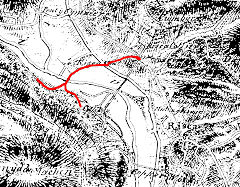
Alternative access to the colliery
|
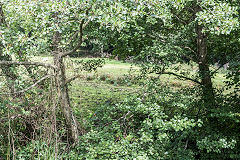
Cae'r Engine at Greenmeadow
|
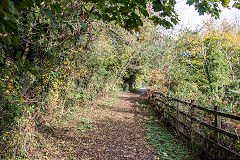
Looking up from the railway
|
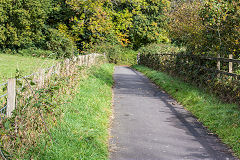
Looking up from the railway
|
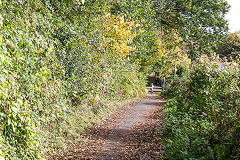
Looking up to the canal
|
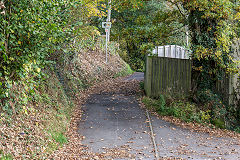
Looking up to the canal
|
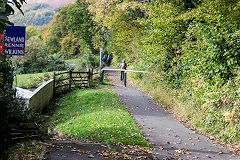
Looking down from the canal
|
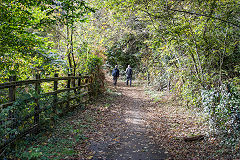
Looking down to the railway
|
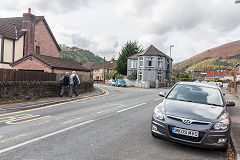
Medart Place crossing site
|
Risca Blackvein Coalworks - Memories of times gone by
Sam Munn lived here in the 1950s and says "I was born in Risca in Garn cottage (by the side of Risca cemetery) 1950 and moved to Buck Farm Danygraig in 1956 (mistakenly identified as Rock Farm in Dave's narrative about the lead mine). I remember many of the old redundant workings, they were haven for us to play in. One lad broke his leg in the Blackvein Drift mine winding gear and my mother and uncle took the front door off our house to use as a stretcher to get him to the farm where he was put into the back of our van and mam took him to hospital (no Air Ambulance back then).
Also my Dad used drive the tractor to pull the Danygraig Brickwork trucks out from the yard to to railway sidings for collection. I spent many a Saturday morning in the weighbridge house and I knew Mrs Campbell next door (called Campbell's corner)
There was no mention of the mystery embankment ring sited at the top of our farm. This was some kind of settlement that had a perfect view to see Newport and and danger coming from down the valley. Many observers came to see it but my father levelled the site in early 60's. As for your question, the (horizontal not vertical) winding wheel headgear was definitely for the Drift mine as we were able to walk into it for about 50 metres. Also the forward area was a slag heap and had remnants of a small railway dram lines. All around the Blackvein and even up on the top part of our farm the area was littered with Bell Pits i.e. small excavations about 3 metres deep. Once they had extracted the coal they just moved over and dug another one. I remember my Father organising stone picking gangs (mainly my friends) to pick up stones from the fields and fill in the pits which he later covered with soil.
Below the farm was a quarry (not working in my memory) and in the quarry floor was a brick works called the Star Brick & Tile. I think it closed in about 1967.
I forgot to mention also that my Grandfather who moved out of Buck Farm when we moved in went to live in the Darren cottages at the canal bridge and i remember much of that area too. "
Dave Bryant adds "A chap I knew who drove one of the big Euclid dump trucks, getting the old Blackvein site ready for the by-pass, said when they were blasting just up past the brick works, they discovered some tunnel workings and tools. These got destroyed, so the project didn't get held up. If that was true, I know not. I remember when the earth scrapers were in the Blackvein, they broke into one of the old coal workings, I remember peering down inside the hole, didn't have a camera though."
Acknowledgments, sources and further reading.
Thanks to Jim Coomer for showing me many things I'd missed and providing some fascinating historical photos.
Thanks also to Barbara Gill, Malcolm Johnson, Bryan Morgan, John Venn and other members of Oxford House Industrial History Society, who have contributed their records, thoughts and ideas.
Gordon Rattenbury - 'Jones Tramroad, Risca' - RCHS journal, Nov 1985
'Archive' magazine No 73
John Etor - private article - April 2004
David Mushett - Papers on Iron and Steel - 1840
Bryan Morgan - 'The Location of Edward Jones' 1799 Tramroad - A personal assessment based on contemporary correspondence' - OHIHS, available on the 'publications' page of the
Risca Museum website
Ray Lawrence - 'The Coal Mines of Risca'
